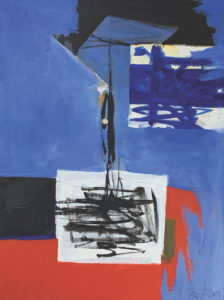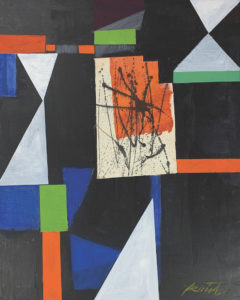
Though Mischa Richter was widely celebrated as a cartoonist, at The New Yorker and elsewhere, he painted fine art canvases seriously and steadily throughout his life. He said of his paintings in 1945, “I don’t show them. If somebody thinks they’re good 20 years from now, why, that will be fine. In the meantime, I don’t have to stand around and be insulted.”
Richter’s son, Dan, a mime and actor — he played the lead ape-man in 2001: A Space Odyssey — tells the Independent that despite what his father’s remark suggests, he did occasionally exhibit his paintings, including a major retrospective at the Provincetown Art Association and Museum in 1999, two years before his death. But he never got the reception he desired.

“He’d show his art,” Dan says, “and people would be, like, where are the cartoons?” Dan says that Richter was also not a fan of schmoozing, which may have been a factor in his low visibility in the fine art world.
Now, 21 years after that PAAM show, the Bakker Gallery in Provincetown has mounted a retrospective of Richter’s paintings. It opens this Friday and will be on view through Sept. 13.
Richter was born in 1910 in the Russian city of Kharkiv, now part of Ukraine. His family fled to America when he was 12. He studied at the School of the Museum of Fine Art, Boston, and then Yale University, where his teachers included Denman Ross and Philip Hale. After graduation, he returned to Boston to paint murals for the W.P.A.
In the late 1930s, Richter did political cartoons for The New Masses, a Communist magazine, and after World War II, his career took off. He was on contract at The New Yorker, freelanced at publications such as the Saturday Evening Post and New York Times, and had a syndicated King Features strip, “Strictly Richter.”
He married Helen Sinclair Annand, whom he had met through painter Will Barnet, an old school friend and Helen’s brother-in-law. He settled with his family in Provincetown in 1958, and he and Helen remained together until her death in 1992 (she suffered from multiple sclerosis). Their son, Dan, has two sons, Sacha, a painter, and Mischa, his grandfather’s namesake, a photographer and filmmaker. All three live at least part-time in Provincetown.

Richter the patriarch was a longtime member of the Beachcombers’ Club and led a rich creative life in town. “He usually had his cartooning done early,” Dan says. “You’d hear him laughing in his studio at 4:30 in the morning. By 9 or 10 he would be finished, and he’d spend the rest of the day painting.” Richter was prolific: Dan says that there are about 350 paintings in the estate, though many more were sold or given away.
Richter’s knowledge of art history was extensive. “He loved artists like Daumier, who did cartooning and painting,” Dan says. “Goya was almost like that. He saw no difference between cartooning and painting. The aesthetic rules were the same, though the function is quite different.”
The work in the Bakker Gallery show offers evidence of aesthetic influences and confluences. Descending, for example, is reminiscent of Robert Motherwell, with its palette of primary colors and calligraphy-like black lines. Though Dan isn’t sure of his father’s relationship to Motherwell, another Provincetown icon, he says that Richter knew many of the abstract expressionists of the day.
Abstract With Splat is a collage. In the center of this geometric, nearly cubist, painting is a piece of paper splattered with ink. This paper, almost like a newspaper clipping or cartoon, is juxtaposed with the painted canvas.
Included in the show is an untitled abstract that resembles stained glass. Richter’s oversized signature, the very same that graces his cartoons, takes up most of the right-hand corner. Alan Bodian wrote of Richter in 2004, “His strongly graphic signature, like an exclamation point, meant he signed off on the work, that he was happy with it.”
Homeless IV is part of a series painted in 1996 and 1997. Because it is figurative, it compares more readily to the cartoons. The painting is almost symbolic — the emotional state of the figure is conveyed through simple shapes and body language.
It’s tempting to try and situate Mischa Richter’s paintings in relation to his cartoons — the stark contrast between them calls out for some sort of explanation or common thread. Richter probably wouldn’t have approved of this. He wanted his paintings to stand on their own. And now, long after he’s gone, we have the remarkable privilege to be able to look at these rarely seen works and decide for ourselves whether they stand the test of time.
Strictly Richter
The event: An exhibit of paintings by Mischa Richter
The time: Aug. 28 through Sept. 13; Thursday through Monday, 11 a.m. to 3 p.m., or by appointment
The place: Bakker Gallery, 359 Commercial St., Provincetown
The cost: Free



